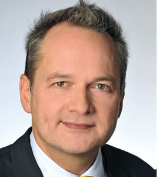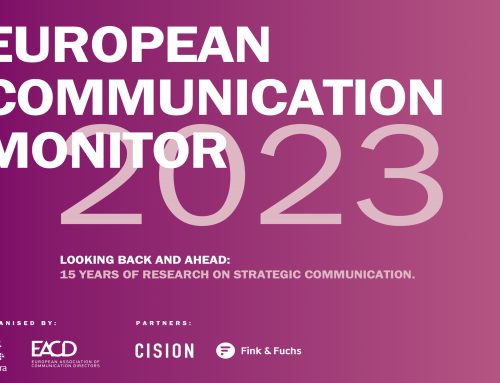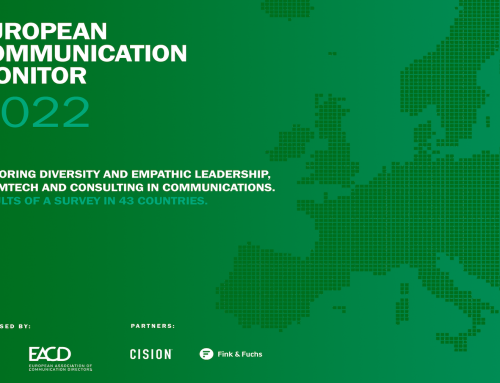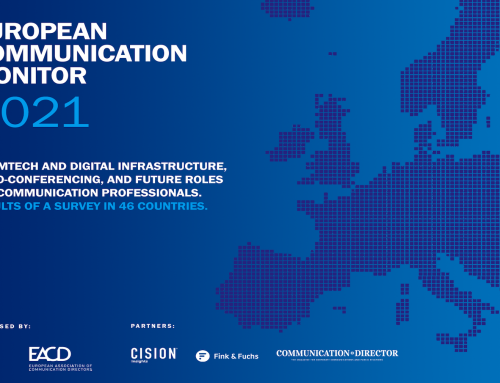 Based on responses from more than 2,750 senior professionals from 42 countries, the European Communication Monitor 2014 reveals that the digital age enriches the jobs of professional communicators, yet many are still struggling to find new working routines. Communicating with stakeholders at any time is the most important aspect of mobile communication for six out of ten communicators in Europe.
Based on responses from more than 2,750 senior professionals from 42 countries, the European Communication Monitor 2014 reveals that the digital age enriches the jobs of professional communicators, yet many are still struggling to find new working routines. Communicating with stakeholders at any time is the most important aspect of mobile communication for six out of ten communicators in Europe.
Although a third of organisations have implemented apps for smartphones and tablets, more than 40 per cent are not planning to use such tools for strategic communication. In contrast, 61 per cent already employ mobile corporate or organisational websites. While 84 per cent state that new ways of communication are enriching their jobs, 73 per cent also say that their daily work pressure is steadily increasing and only 57 per cent know how to handle the constant information flow.
The results have been released on the European Communication Summit in Brussels on July 10 by the European Public Relations Education and Research Association (EUPRERA) and the European Association of Communication Directors (EACD).
Statements from the lead researcher and the EACD president
 Professor Ansgar Zerfass, lead researcher of the survey, explained:
Professor Ansgar Zerfass, lead researcher of the survey, explained:
“The digital age has created new job routines that stimulate questions about (1) work load,(2) job satisfaction and (3) career development through networking and mentoring. At the same time, organisations ask for stakeholders’ expectations for their communication and the effectiveness of these new routines. An important topic which connects both developments is excellence. New role models for professional communicators might be drivers of excellent communication functions, while in turn outperforming functions can offer interesting and rewarding tasks for communicators.”
 Dr. Herbert Heitmann, president of the European Association of Communication Directors (EACD) added:
Dr. Herbert Heitmann, president of the European Association of Communication Directors (EACD) added:
“The findings present a diverse picture of the European communication landscape. Most communicators are satisfied with their jobs, because they place greater importance on satisfaction-drivers such as interesting tasks instead of aspects such as work-life balance. An especially pressing issue for nearly half of the survey’s respondents is the challenge of linking communication and business strategies. The European Association of Communication Directors (EACD) and its members are prepared to bring this essential relationship firmly into the foreground.”
Communicating in the digital age
The ECM 2014 clearly shows that the way communication professionals work has been changed by the digital age and rising demands from stakeholders. Respondents report about an increasing pressure in their jobs. At the same time, technology creates more opportunities. Part of this change is an increase in information flow which top level communicators seem better equipped to deal with. When analysing the increased work pressure on gender lines, women report a higher pressure, but they are also better at utilising the changing technology in their work.
Again focussing on different demographic groups it is the young professionals who report an increased obligation to be ‘always online’.  Yet they feel that the digital age is not negative but rather provides job enrichment and also makes work easier for them. Practitioners working in traditional areas like media relations rate positive impacts comparatively low but feel the highest pressure.
Yet they feel that the digital age is not negative but rather provides job enrichment and also makes work easier for them. Practitioners working in traditional areas like media relations rate positive impacts comparatively low but feel the highest pressure.
Work-life balance and work load are important considerations for many professionals. The study shows that the majority of communicators in Europe are working well beyond their contracted hours. Nearly half (47.2 per cent) work at least one quarter more than formally required in the average week, with a small sub group of this number (8.8 per cent) claiming they work at least 50 per cent more than they have to. When we drill further into the figures it is the practitioners in the joint stock companies and agencies that work significantly more of this overtime than their colleagues in other areas.
Mobile communication
 Mobile communication platforms such as smartphone apps or mobile websites have been identified as a fast growing area in this study. Previous editions of the ECM survey have shown that there is a large gap between the perceived importance and the real implementation of mobile media. This year’s study has explored relevant perceptions in more detail. Approximately one third of the organisations in the sample have implemented apps for smartphones (37.3 per cent) and tablet computers like iPads (34.1 per cent) by now. According to the respondents, these figures may rise above 50 per cent by the end of the year.
Mobile communication platforms such as smartphone apps or mobile websites have been identified as a fast growing area in this study. Previous editions of the ECM survey have shown that there is a large gap between the perceived importance and the real implementation of mobile media. This year’s study has explored relevant perceptions in more detail. Approximately one third of the organisations in the sample have implemented apps for smartphones (37.3 per cent) and tablet computers like iPads (34.1 per cent) by now. According to the respondents, these figures may rise above 50 per cent by the end of the year.
However, the most implemented (61.3 per cent) and also the most planned use of mobile applications (another 20.9 per cent until the end of 2014) can be located in the area of mobile corporate/organisational websites. Joint stock companies are most active here, and they are even more clearly ahead in integrating apps into the communication portfolio. A majority of the communicators in Europe see the main opportunities of mobile communication in enabling communication with stakeholders at any time (59.5 per cent), user-friendly content presentation (53.7 per cent) and reaching younger publics (40.4 per cent).
The main challenges are related to integrating mobile media with other channels and platforms (57.9 per cent), finding conclusive concepts which create added value (47.3 per cent) and presenting complex content on small screens (45.9 per cent). Communicators in companies recognise the more strategic value of mobile applications, while others value operational benefits much higher. Also challenges were divided between strategic, operational and pragmatic challenges. In this case, there are almost no differences between various types of organisations. All of them face mainly operational challenges like aligning mobile media to other platforms and developing mobile skills among communication professionals.
Job attributes and satisfaction
Communication professionals across Europe enjoy a stimulating job. They experience their tasks as interesting and varied (77.3 per cent) and they feel valued by their superiors and (internal) clients (66.7 per cent). On the other hand, only slightly more than a third of them find their salary adequate (37.6 per cent), work-life balance right (36.3%) and see enough opportunities in their personal career (36.1 per cent).  Compared to the measurement done four years ago for the same study series, communication professionals rate their job situation lower an all dimensions. The economic crisis with its spill-over into social and political systems has obviously taken its toll in all types of organisation. Most practitioners (66.5 per cent) are still satisfied with their actual job situation. Denmark, Austria, the Netherlands and Norway seem to provide the best communication work environment with Romania and Belgium the worst. The strongest drivers of job satisfaction are (in descending order) interesting and manifold tasks, great career opportunities, appreciation from superiors and (internal) clients and status of the job. Adequate salary, job security and stability and work-life balance are less important. This explains the good level the job satisfaction in spite of the drawbacks reported for some aspects. The survey also reveals an interesting
Compared to the measurement done four years ago for the same study series, communication professionals rate their job situation lower an all dimensions. The economic crisis with its spill-over into social and political systems has obviously taken its toll in all types of organisation. Most practitioners (66.5 per cent) are still satisfied with their actual job situation. Denmark, Austria, the Netherlands and Norway seem to provide the best communication work environment with Romania and Belgium the worst. The strongest drivers of job satisfaction are (in descending order) interesting and manifold tasks, great career opportunities, appreciation from superiors and (internal) clients and status of the job. Adequate salary, job security and stability and work-life balance are less important. This explains the good level the job satisfaction in spite of the drawbacks reported for some aspects. The survey also reveals an interesting  trajectory of career development in the communication profession. For instance, job attributes and satisfaction change with age. Overall job satisfaction is related to one’s position in the hierarchy: the most satisfied are those on the top (heads of communication and agency CEOs), while the least are those on the bottom (team members and consultants). But the top position comes with the price of an unbalanced work-life situation. Also functional responsibilities matter: those working on strategy and coordination are more satisfied with their jobs than those working in media relations, online and internal communications.
trajectory of career development in the communication profession. For instance, job attributes and satisfaction change with age. Overall job satisfaction is related to one’s position in the hierarchy: the most satisfied are those on the top (heads of communication and agency CEOs), while the least are those on the bottom (team members and consultants). But the top position comes with the price of an unbalanced work-life situation. Also functional responsibilities matter: those working on strategy and coordination are more satisfied with their jobs than those working in media relations, online and internal communications.
Career development
According to the ECM 2014, the three most important factors for obtaining a good position in strategic communication are networking among peers and  colleagues (78 per cent), further education on or off the job (71 per cent), and moving to a new employer (71 per cent). For young employees the most significant factor was having work experience or an internship prior to the job (74 per cent). While for the mid career, middle aged employees (30-39 and 40-49) the most significant career booster is changing their employer (74.4 and 72.1 per cent respectively).
colleagues (78 per cent), further education on or off the job (71 per cent), and moving to a new employer (71 per cent). For young employees the most significant factor was having work experience or an internship prior to the job (74 per cent). While for the mid career, middle aged employees (30-39 and 40-49) the most significant career booster is changing their employer (74.4 and 72.1 per cent respectively).
Geographically the study has identified regional differences. In Southern Europe, networking is reportedly more important for career development than in Northern Europe. Other marked regional differences are for job rotation, which is seen as more important in the East and South as well as specifically in France, Belgium and the Netherlands. Internships on the other hand are less valued in Norway, Sweden and the United Kingdom.
Mentoring
Mentoring is seen as important by a clear majority of communication professionals. Interestingly, both the youngest and oldest, most experienced practitioners name mentoring as one of the top three aspects of career development. The ECM 2014 data has revealed significant correlations between mentoring and job satisfaction. Communication professionals who had been mentors as well as mentees during their career are most satisfied in the job, followed by those who had  been mentors and those who had only been mentees. Despite these positive effects, one third of the respondents never had a mentor. Female respondents have been less involved in mentoring programmes than their male counterparts. Those professionals are excluded from several positive effects of mentoring identified in the study. Thinking of the future, tailor-made mentoring programs for communicators seem to be a valuable approach to develop communication functions in organisations and the profession at large.
been mentors and those who had only been mentees. Despite these positive effects, one third of the respondents never had a mentor. Female respondents have been less involved in mentoring programmes than their male counterparts. Those professionals are excluded from several positive effects of mentoring identified in the study. Thinking of the future, tailor-made mentoring programs for communicators seem to be a valuable approach to develop communication functions in organisations and the profession at large.
Networking practices and platforms
Networks are relevant for communicators both in formal manifestations and in an informal nature. 82.5 per cent of respondents agreed that networking is important for career progression and personal development and about the same number (82.4 per cent) saw networks as important for reaching business and communication goals of the organisation. There are clearly mixed motives behind many networking activities, which has to be considered when developing and evaluating appropriate strategies in practice. Online media offer new opportunities for networking. But concerns about privacy and information security have raised doubts about the suitability of those platforms in professional environments.
The ECM 2014 has addressed this issue and investigated preferred forms of networking among communicators.  Overall, e-mail is first choice, followed by social media and face-to-face interactions. There are interesting differences in how networking practices are perceived. When compared with the phone and social media, face-to-face is seen as the most professional, trustworthy and productive form by the majority of respondents.
Overall, e-mail is first choice, followed by social media and face-to-face interactions. There are interesting differences in how networking practices are perceived. When compared with the phone and social media, face-to-face is seen as the most professional, trustworthy and productive form by the majority of respondents.
There are regional differences, too. Networking through social media is practiced most often in Finland, the United Kingdom, and Norway. E-mail is more relevant in parts of Eastern and Southern Europe (Russia, Croatia, Serbia, Spain) as well as in Belgium. Germans are significantly more geared to the phone than peers in other parts of Western and Northern Europe. While only 10.0 per cent of professionals use the phone as their premier networking tool, a clear majority states that using the phone is the most formal and time efficient form of networking.
The ECM 2014 reveals that other platforms are better suited than Facebook for professional networking – business communities such as Linkedin, Xing or Viadeo are rated important by 72.7 per cent of the respondents, and outperform both Twitter (supported by 44.3 per cent) and Facebook (29.5 per cent).
Strategic issues for communication professionals
Unlike in previous years, one topic is clearly heading the list of most important challenges for communication management within the next three years. Nearly half of the 2,777 respondents in the ECM 2014 survey (44.9 per cent) stated that the profession has to tackle the ongoing challenge of linking communication and business strategies. The profession is striving for a strategic position at the decision-making table in order to become a part of the strategic management of an organisation. Only one third of the professionals interviewed (32.0 per cent) still believe that coping with the digital evolution and the social web is one of the top challenges. This number has declined sharply from 41.8 per cent. It looks like many questions have been answered; the novelty and hype are over. The most interesting trajectory involves the issue of dealing with sustainable development and social responsibility. This much-debated field started as second in the list of most important issues for communications in the 2008 monitor, and fell to lower places during the last year. In 2014, practitioners rated it in the ninth place with only 16.2 per cent picking this topic. These results signal that communication professionals have learnt how to deal with the challenges, or that normative exaggerations have now been replaced.
Communication channels and social media
 The dynamics of the field are also visible when exploring the importance of various channels and instruments in strategic communication. Online communication is clearly leading this list (rated important by 85.9 per cent), with face-to-face communication (81.0 per cent) and media relations addressing online media (79.0 per cent) just behind. However, the latter is supposed to increase in relevance during the next years, as is online communication itself, while face-to-face will stay at the same level.
The dynamics of the field are also visible when exploring the importance of various channels and instruments in strategic communication. Online communication is clearly leading this list (rated important by 85.9 per cent), with face-to-face communication (81.0 per cent) and media relations addressing online media (79.0 per cent) just behind. However, the latter is supposed to increase in relevance during the next years, as is online communication itself, while face-to-face will stay at the same level.
The survey suggests a dramatic loss of importance for traditional press relations interacting with print media. Only 41.8 per cent of the respondents believe such activities will be important in 2017, which is far less than today (76.3 per cent) and a strong decline since 2011 and 2008, when this has been the most important of all instrument). On the contrary, mobile communication will see the strongest rise within the near future.
An interesting picture emerges when turning the perspective and asking not for organisational activities, but for the expectations of stakeholders in the realm of social media communications. According to the ECM 2014, stakeholders expect organisations to provide real-time information on events or crises on social platforms, to inform about current or forthcoming products or services, and to discuss corporate social responsibility activities. The key terms on social media are interaction, joint experiences, and feedback. One could conclude that the power is equalising between organisations on one side and their stakeholders on the other. But the decline of journalism and other independent intermediaries also support another interpretation. Probably the levelling of the playing field is not so much a sign of more dialogic times, but of a new asymmetry between communicating parties.
Gender and feminisation of the profession
Demographic data across Europe prove the ongoing feminisation of the communication profession. As such it is important to understand whether barriers and prejudices identified in earlier research still exist, or whether the intense debate on gender in communications has had an impact. The ECM 2014 answers these questions from an empirical point of view, which does not impede normative judgements. Approximately one third of all respondents supports the claim that feminisation will encourage the practice to move towards more professionalism and symmetrical communication. Opinions among communication practitioners  were quite divided when the impact of a gender shift on the image of the profession was discussed. 36.6 per cent disagreed that the soft image of communications will be perpetuated, 33.4 were neutral and 30.0 per cent supported this view.
were quite divided when the impact of a gender shift on the image of the profession was discussed. 36.6 per cent disagreed that the soft image of communications will be perpetuated, 33.4 were neutral and 30.0 per cent supported this view.
Apart from these generalised perceptions, respondents were asked to report about the concrete situation of female communicators in their organisation. Only one aspect was more often approved than rejected: 40.7 per cent stated that female professionals need more time for private obligations (i.e. children or other family members) compared to men, which was denied by 38.2 per cent of the communicators.
The study also shows that many traditional prejudices between the genders are still prevalent in Europe and often related to gender traits. Men are more often seen as being aggressive, able to promote themselves, self confident, and politically savvy. Women score better in terms of management skills, emotion and sensitivity to people. But men and women interpret these issues quite differently. Differing worldviews and experiences have to be taken into account when discussing gender issues.
Excellent communication departments
Benchmarking approaches based on self-assessments are established methods to identify excellent organisations as well as drivers of excellence within a field. Such approaches have been used for a long time in business and management. The ECM 2014 employs a new method to identify excellent communication functions, combining conceptual considerations with self-assessments of communication professionals and statistical analyses to identify characteristics which make a difference. The sample was divided between organisations with excellent communication functions and all other organisations.
Excellence is based on the internal standing of the communication function within the organisation (influence) and external results of the communication function’s activities as well as the function’s basic qualifications (performance). Each of these two components were calculated on the basis of two dimensions. Only organisations clearly outperforming in all four dimensions are considered as excellent in the benchmark exercise. The analysis revealed that approximately one out of five communication functions in the sample can be considered excellent (21.2 per cent). The highest proportion can be found in joint stock organisations (24.9 per cent), whereas excellence is less prevalent in government-owned, public sector and political organisations (16.0 per cent).
There are significant differences between excellent and normal communication functions. Excellent communication functions have stronger alignment with top management, as the head of communication is more often part of the executive board or reporting directly to the CEO. In those departments, 81.1 per cent of the professionals act as strategic facilitators who plan and execute communications, but at the same time help to define new business strategies – compared to 52.7 per cent in other organisations. Excellent functions also have different priorities. They are less concerned with linking business strategy and communication, as many have probably established routines for alignment. However, they are more involved with corporate social responsibility and CEO positioning. Practitioners working in excellent departments are better prepared to know how to deal with new technologies, but they also report more work pressure. There is more overtime in excellent functions, but practitioners experience higher levels of job satisfaction.
Most interestingly and related to discussions in previous chapters, there is also a significantly higher level of gender equality in organisations with an excellent communication function. These results indicate that there are differences between excellent and other, normal communication functions in Europe not only in technical proficiency of doing communication, but also regarding worldviews. In that respect organisations with excellent communication functions are not simply better at communication, they are communicatively different. Further research is needed to explain this linkage between technical proficiency and social reflexivity. The results demonstrate that strategic communication is more than a craft and that to practice it well practitioners need a profound understanding of business, organisations and society.
Report, video and further material available
The PDF report with full results as well as a video featuring highlights from the study as well as more material like 10 Starting Points for Discussion or articles published in the Communication Director Magazine are available here.







